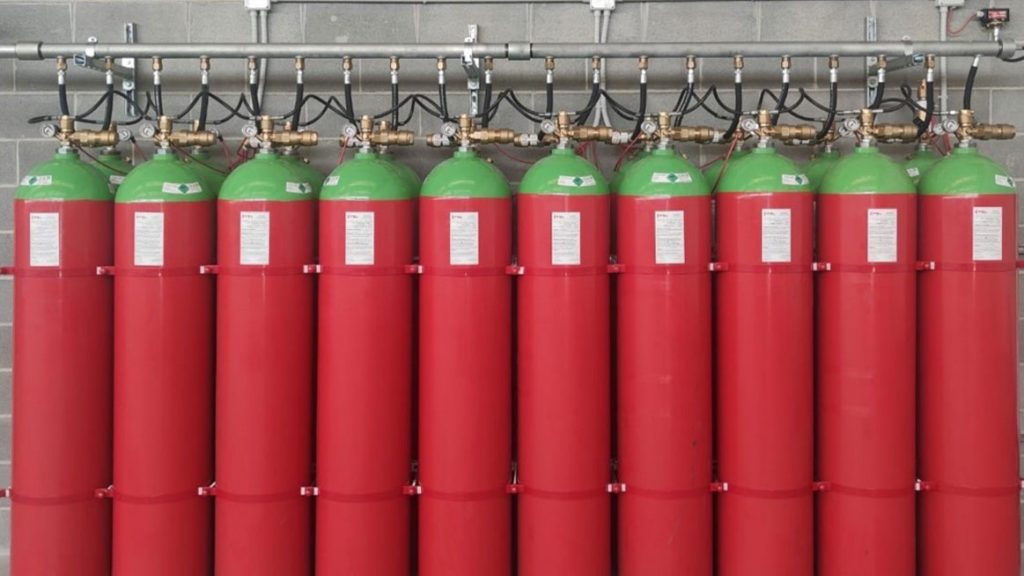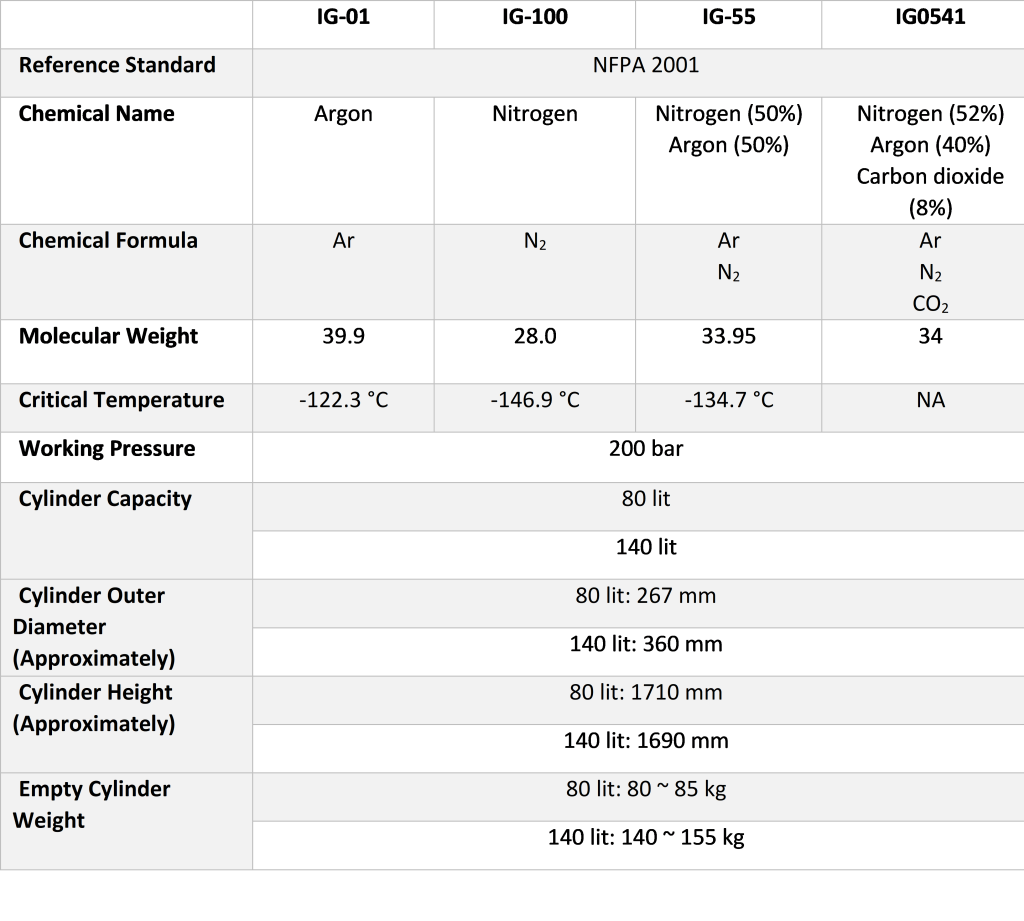Inert gases (IG), are widely used to protect sensitive areas (such as museums, server rooms, control rooms, etc.) from fire. IG fire suppression systems are designed as a subgroup of clean agents according to the NFPA 2001 standard and unlike CO2 systems, can be used in rooms that are normally occupied by people.

Inert gases used in fire suppression systems are primarily composed of nitrogen (N2), argon (Ar), or a mixture of these gases. The table below lists the IG agents approved by the NFPA 2001 standards.
| IG-541 | Nitrogen (52%), Argon (40%), CO2 (8%) |
| IG-55 | Nitrogen (50%), Argon (50%) |
| IG-01 | Argon |
| IG-100 | Nitrogen |
Inert gases in the vicinity of the fire displace air and typically reduce the oxygen level to below 12%, extinguishing the fire. The required amount of gas for extinguishing is determined by the design concentration. Using these gases at the appropriate concentration can extinguish flames caused by flammable liquids or solids. These substances leave no residue after discharge, eliminating the need for post-fire cleanup of the extinguishing agent. Additionally, they do not create harmful chemical compounds when exposed to high temperatures.
The main features of inert gas (IG) fire suppression systems include:
- Inert gases are colorless and odorless at room temperature and pressure.
- They are non-conductive of electricity.
- They are non-corrosive and do not decompose when exposed to flames and high heat.
- They leave no residue after discharge
Inert gases are typically stored in 80 and 140 liter cylinders at a pressure of 200 bar.
The storage of IG cylinders requires more space than halocarbon fire suppression systems.
- The extinguishing mechanism of inert gases is to reduce the oxygen concentration. For this purpose, the IG gas must be discharged in the space at an appropriate concentration.
- The IG systems are almost always used as a total flooding system.
- If the requirements of the standard are met, humans can be exposed to it for a maximum of 5 minutes.
When choosing gas systems for fire protection, the cost, the possibility of complete sealing of the area to keep the gas for the standard period, and the space required for storing the cylinders should be considered as influencing factors.
Applications of IG Systems
IG systems can be effectively used to extinguish Class A, Class B, and Class C fires. However, they are not suitable for extinguishing Class D fires and materials that produce oxygen when burned, such as nitrocellulose and gunpowder.
This system is especially used in enclosures where one (or more) of the following conditions are true:
- People are present in the area, either normally or permanently, and there is a need to protect human life.
- The presence of electrical equipment makes it necessary to use a non-conductive material.
- Other extinguishing agents, such as water, powder, or foam, can damage equipment and materials or are expensive to clean up.
- The space required to store the large volume of IG storage cylinders is not a major issue.
Some industrial areas where CO2 systems can be used include:
- Control rooms and engineering rooms
- Computer rooms
- Server rooms and data centers
- Telecommunications centers
- Museums
- Archive rooms
- Libraries
- Electrical rooms (such as switchgear rooms, cable galleries, etc.)
Effects of IG Gases on Humans
The negative effects of exposure to inert gases can only be caused by a decrease in oxygen concentration, and these substances have no chemical or toxic effects on the human body. However, IG fire suppression systems should be designed and implemented in a way that prevents unnecessary exposure of people to low oxygen concentrations in the air.
NFPA 2001 Standard
The NFPA 2001 standard defines two limits based on the concentration of the extinguishing agent in the air and the potential hazards:
- NOAEL or No Observed Adverse Effect Level, which is the maximum concentration of the extinguishing agent in the air at which no adverse physiological or toxic effects have been observed.
- LOAEL or Lowest Observable Adverse Effect Level, which is the minimum concentration of the extinguishing agent in the air at which an adverse physiological or toxic effect has been observed.
The following table shows the NOAEL and LOAEL limits for IG systems according to the NFPA 2001 standard:

According to the above table, none of the IG systems up to 43% by volume in the air will cause a physologic or toxic effect on the human body and up to 52% concentration will cause the least adverse effects.
According to the NFPA 2001 standard, if IG fire suppression systems are designed with a concentration of less than or equal to 43% (in this case, the remaining oxygen concentration in the area will be 12%), people can be present in the area for a maximum of 5 minutes. If the IG fire suppression system is designed for a concentration between 43% and 52% (in this case, the remaining oxygen concentration in the area will be between 10% and 12%), people can be present in the area for a maximum of 3 minutes.
It is also necessary to avoid designing IG fire suppression systems for areas where people are normally present (normally occupied spaces) with a concentration higher than 52%.
IG Storage Cylinders
Inert gases are usually stored in cylinders with capacities of 80 and 140 liters. The nominal working pressure of these cylinders can be 200 bar or 300 bar, which 200 bar systems being more commonly used than 300 bar systems.
The following table shows the capacity of IG cylinders at 15 degrees Celsius, in kilograms. Please note that these values are approximate and may change.


Technical Specifications of IG Fire Extinguishing System:


